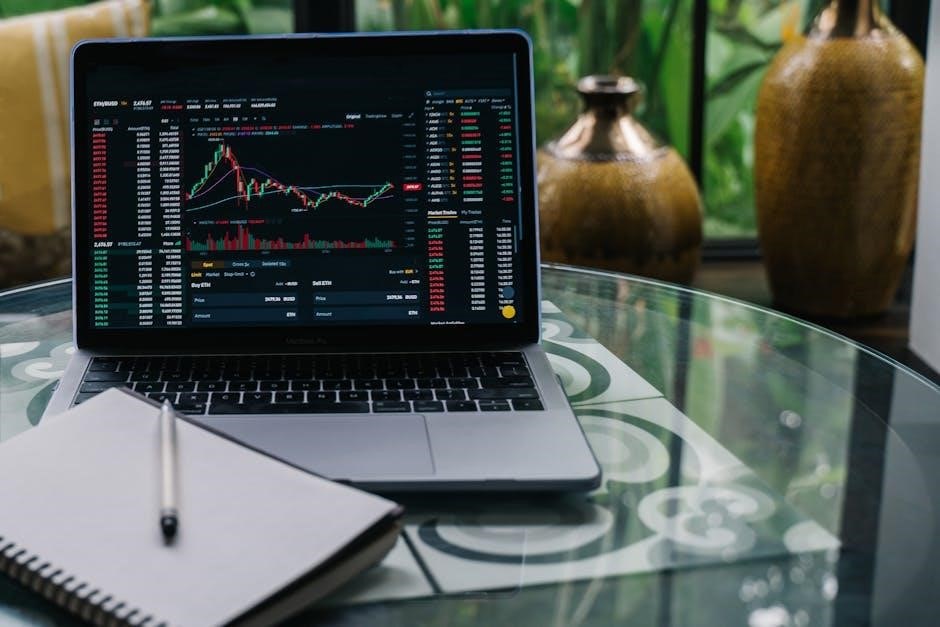Sous vide cooking offers precise temperature control for consistent results, ensuring evenly cooked dishes․ This method seals food in bags and cooks it in water at specific temperatures․
Overview of Sous Vide and Its Importance
Sous vide cooking is a method where food is sealed in bags and cooked in water at precise temperatures․ This technique ensures even cooking and prevents overcooking․ It’s ideal for achieving consistent results, especially for proteins like steak, eggs, and fish․ The sous vide temperature chart PDF serves as a guide, providing optimal temperature ranges for various foods․ This chart is essential for both beginners and experienced cooks, as it guarantees food safety and desired doneness․ By following the chart, cooks can experiment with different doneness levels and explore the full potential of sous vide․
Why Temperature Control Matters in Sous Vide
Temperature control is crucial in sous vide cooking as it ensures consistent results and prevents overcooking․ Precise temperatures guarantee that food reaches the desired doneness without variation․ This level of control is especially vital for delicate ingredients like eggs and fish, where even a small temperature deviation can affect texture and flavor․ Using a sous vide temperature chart PDF helps maintain accuracy, ensuring that each dish is cooked to perfection every time․ This precision also enhances food safety by keeping temperatures within safe ranges, avoiding the danger zone․

Understanding Sous Vide Temperature Charts
Sous vide temperature charts provide detailed guidelines for cooking various foods, ensuring optimal results․ They list precise temperatures and times for proteins, vegetables, and more․
How to Read a Sous Vide Temperature Chart
Reading a sous vide chart is straightforward: identify the food type, desired doneness, and corresponding temperature and time․ For example, beef cooked to medium-rare requires 130°F for 1-6 hours․ Each entry specifies temperature ranges and durations, ensuring precise control․ Charts also differentiate cooking times based on food thickness․ Always refer to the chart for accurate results, adjusting settings as needed for personal preference․ This guide is essential for achieving consistent, restaurant-quality dishes at home․
Key Factors Influencing Sous Vide Temperatures
Sous vide temperatures are influenced by food type, thickness, and desired doneness․ Thickness impacts cooking time, as thicker cuts require longer durations․ The type of food, such as beef, poultry, or fish, determines the ideal temperature range․ Desired doneness, like rare or well-done, also plays a role․ Additionally, the initial temperature of the food and water bath stability affect results․ These factors ensure precise control, making the sous vide method versatile and effective for achieving consistent, high-quality outcomes․ Always consult a chart for specific guidelines․

Protein-Specific Temperature Guidelines
Protein-specific guidelines ensure each type is cooked to the right temperature for optimal results, whether it’s beef, poultry, fish, or eggs, tailored to their unique needs․
Beef: Rare to Well-Done Temperature Ranges
Sous vide beef temperatures range from 50°C (122°F) for rare to 65°C (149°F) for well-done․ Rare beef is cooked at 50-54․4°C (122-130°F), medium-rare at 54․4-57․2°C (130-135°F), medium at 57․2-60°C (135-140°F), medium-well at 60-63․8°C (140-147°F), and well-done at 63․8-65°C (147-149°F)․ These precise ranges ensure beef is cooked to the desired doneness consistently․ Sous vide eliminates guesswork, making it easy to achieve perfect results for any preference․
Pork: Optimal Temperatures for Different Cuts
Pork temperatures vary by cut and desired doneness․ Pork chops are typically cooked at 62°C (144°F) for medium-rare, while tenderloin is best at 65°C (149°F)․ Belly and ribs require higher temps, around 80°C (176°F), for tender, unctuous texture․ Ground pork should reach 71°C (160°F) for safety․ Sous vide ensures even cooking, preventing overcooking and preserving juices․ Always refer to a sous vide chart for precise times and temps to achieve perfect results for any pork dish․ Consistency is key with this method, ensuring delicious outcomes every time․
Poultry: Safe and Desired Temperature Levels
Sous vide poultry cooking ensures food safety and consistency․ Chicken breasts are typically cooked at 65°C (149°F) for medium-rare to 70°C (158°F) for well-done․ Legs and thighs benefit from higher temps, around 75°C (167°F), for tender results․ Turkey breasts are best at 65-70°C (149-158°F)․ Pasteurization at 54°C (130°F) for 1-3 hours ensures safety․ Always use a sous vide chart to verify temps and times, ensuring poultry is cooked to a safe internal temperature while maintaining juicy texture and flavor․ This method prevents overcooking and guarantees perfect doneness every time․
Fish and Seafood: Precision Temperature Control
Sous vide excels in cooking delicate fish and seafood by maintaining precise temperatures; Cod is often cooked at 65°C (149°F) for 30 minutes, while baby squid requires 55°C (131°F) for 7 minutes․ Cuttlefish and eel benefit from slightly higher temps, around 64°C (147°F) and 59°C (138°F), respectively․ Sous vide ensures even cooking without overcooking, preserving moisture and flavor․ Use a sous vide chart for exact times and temps, ensuring seafood is perfectly cooked while maintaining its tender texture․ This method is ideal for achieving consistent, restaurant-quality results․
Eggs: Sous Vide Cooking Temperatures
Sous vide cooking provides exceptional control for preparing eggs to desired doneness․ For perfect poached eggs, cook at 75°C (167°F) for 14 minutes․ Lower temperatures, like 55°C (131°F), are ideal for pasteurization or soft-boiled eggs, requiring 45 minutes․ Adjusting time and temperature ensures yolks and whites are cooked to your liking․ This method eliminates overcooking, delivering consistent results․ Use a sous vide chart to explore precise settings for various egg dishes, from runny yolks to fully set whites, achieving culinary perfection every time․
Vegetables: Enhancing Flavor Through Temperature
Sous vide cooking allows for precise control over vegetable textures and flavors․ Cooking at lower temperatures, such as 80°C (176°F), preserves vibrant colors and crispness in green beans or broccoli․ Higher temperatures, around 90°C (194°F), soften root vegetables like carrots or beets without overcooking․ The method ensures even cooking throughout, enhancing natural flavors․ Use a sous vide chart to explore ideal settings for various vegetables, achieving perfect doneness and texture․ This technique prevents overcooking, making it ideal for delicate or hearty plants alike․

Cooking Times and Thickness Considerations
Cooking time in sous vide depends on food thickness, with thicker cuts requiring longer durations․ A 2-inch thickness typically cooks in 1-4 hours, ensuring even doneness without overcooking․
How Cooking Time Relates to Food Thickness
Cooking time in sous vide is directly influenced by the thickness of the food․ Thicker cuts require longer cooking periods to ensure even doneness throughout․ For example, a 1-inch steak might cook in 1-2 hours, while a 2-inch steak could take 2-4 hours․ This ensures that the internal temperature reaches the desired level without overcooking the exterior․ The sous vide method allows for precise control, making it easier to achieve consistent results regardless of the food’s thickness․ Proper timing ensures tender, evenly cooked dishes every time․
Adjusting Times for Different Doneness Levels
Cooking time in sous vide varies based on the desired doneness of the dish․ For rare meats, lower temperatures and shorter times are used, while well-done requires higher temperatures and extended periods․ For example, a rare steak might cook at 130°F for 1-3 hours, while a medium steak could take 140°F for 1-4 hours․ The sous vide method allows for precise adjustments, ensuring the food reaches the exact doneness level without overcooking․ This flexibility makes it ideal for achieving consistent, restaurant-quality results at home․
Food Safety and Sous Vide
Sous vide ensures food safety by maintaining precise temperatures, avoiding the bacterial growth risk in the 5°C to 55°C danger zone․ Always follow safe guidelines․
Safe Temperature Ranges for Sous Vide
Sous vide cooking requires adherence to safe temperature ranges to prevent bacterial growth․ Food should not remain in the danger zone of 5°C to 55°C for extended periods․ Typically, cooking temperatures range from 50°C to 90°C, ensuring pathogens are eliminated․ For example, poultry needs to reach at least 65°C, while beef can be safely cooked at lower temperatures for rare doneness; Always refer to a sous vide temperature chart to ensure food safety and optimal results․ Proper guidelines help maintain quality and prevent health risks․
Avoiding the Danger Zone: 5°C to 55°C
The danger zone for food is between 5°C and 55°C, where bacteria thrive, multiplying rapidly․ Sous vide cooking minimizes this risk by precisely controlling temperatures․ Never store food in this range for over four hours, as it can lead to spoilage and health hazards․ Use your sous vide temperature chart to ensure food is heated or chilled promptly․ This method ensures safety while maintaining the quality and flavor of your dishes․ Always prioritize temperature control to avoid potential contamination and keep your meals safe and enjoyable․

Using the Sous Vide Temperature Chart PDF
Download and print the sous vide temperature chart PDF for quick reference․ It provides precise times and temperatures for meats, fish, eggs, and vegetables, ensuring perfect doneness․
Downloading and Printing the Chart
The sous vide temperature chart PDF is readily available for download from various culinary websites․ It provides detailed temperature and time guidelines for meats, fish, eggs, and vegetables․ Once downloaded, printing the chart on high-quality paper ensures durability․ Many chefs laminate it for kitchen use, making it resistant to moisture․ The chart serves as a quick reference, helping cooks achieve perfect doneness every time․ It’s an essential tool for both home cooks and professionals, ensuring consistent results in sous vide cooking․
The sous vide temperature chart PDF is a invaluable kitchen tool, providing precise guidelines for cooking various proteins and vegetables․ By referencing the chart, cooks can quickly determine ideal temperatures and times for desired doneness․ For instance, beef can be cooked to rare at 130°F (54․4°C), while chicken breast is best at 150°F (65․5°C)․ This ensures food safety and flavor consistency․ The chart also accounts for thickness and cooking durations, making it a comprehensive guide for achieving perfect results in sous vide cooking․ It’s a must-have for any kitchen aiming for culinary excellence․ The sous vide temperature chart PDF is an essential guide, ensuring perfect doneness and consistency․ It’s a valuable tool for home cooks and professionals alike, enhancing culinary precision and safety․ The sous vide temperature chart PDF provides precise guidelines for cooking various proteins and vegetables․ It outlines optimal temperatures and times for achieving desired doneness levels, from rare to well-done․ For beef, temperatures range from 50°C for rare to 70°C for well-done․ Pork and poultry have specific safe temperature thresholds, while fish and seafood require careful control to avoid overcooking․ Eggs and vegetables also benefit from sous vide, with charts offering detailed parameters․ This comprehensive guide ensures food safety and enhances flavor, making it indispensable for both home cooks and professionals․ Consistent results are guaranteed with proper use․ For flawless sous vide cooking, use a reliable temperature chart to guide your process․ Pre-season meats and vacuum-seal properly to prevent flavor loss․ Ensure consistent water bath temperature and monitor thickness for accurate cooking times․ Store food safely below 5°C or above 55°C to avoid bacterial growth․ Experiment with finishing techniques like searing for texture․ Always refer to trusted charts for specific proteins, from beef to fish, to achieve desired doneness․ Patience and precision are key to unlocking sous vide’s full potential, delivering restaurant-quality meals consistently․Practical Application in the Kitchen
Final Tips for Perfect Sous Vide Results
